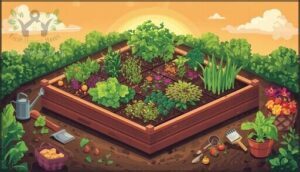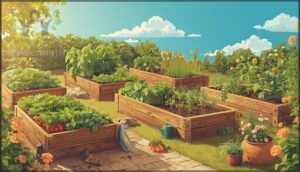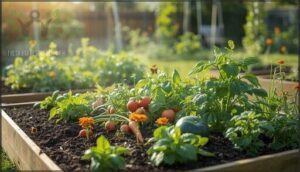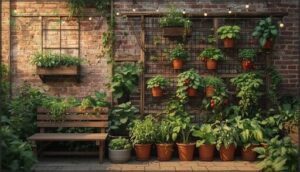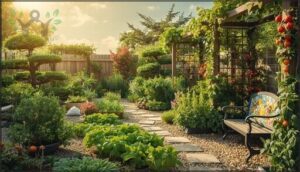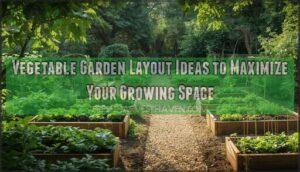This site is supported by our readers. We may earn a commission, at no cost to you, if you purchase through links.
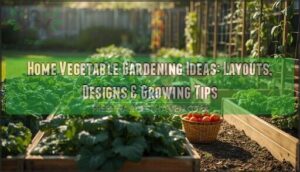
The catch? Most gardeners waste space with inefficient layouts, lose crops to preventable pests, and watch their beds sit idle for months. Smart design changes that. Square-foot gardening, vertical trellises, and succession planting transform cramped yards into year-round harvest machines.
Whether you’re working with a balcony, a postage-stamp plot, or a full suburban lot, strategic home vegetable gardening ideas turn limitations into advantages—producing more food in less space with half the maintenance.
Table Of Contents
- Key Takeaways
- Space-Efficient Vegetable Garden Layouts
- Creative Vertical and Container Gardening Ideas
- Themed and Aesthetic Garden Designs
- Sustainable and Water-Efficient Gardening Tips
- Protecting and Maintaining Your Vegetable Garden
- Frequently Asked Questions (FAQs)
- Can you grow vegetables in a large garden?
- What is the best vegetable garden layout?
- What makes a good vegetable garden?
- How do I choose a vegetable garden design?
- How do you grow a vegetable garden?
- What is the easiest vegetable to grow at home?
- What is a good layout for a vegetable garden?
- How should I arrange my vegetables in my garden?
- What vegetables shouldn’t be planted next to each other?
- When should I start planting vegetable seeds?
- Conclusion
Key Takeaways
- Space-efficient layouts like square-foot gardening and raised beds can produce 80% more vegetables in 20% less space than traditional rows, while vertical growing methods boost yields up to 13.8 times higher than flat gardens.
- Companion planting and succession strategies cut pest damage by 70%, increase harvests by 32%, and keep beds productive year-round by rotating quick crops with long-season vegetables to eliminate idle periods.
- Drought-resistant vegetables like tepary beans, chickpeas, and Roma tomatoes paired with drip irrigation systems slash water use by 37-90% while maintaining or increasing yields compared to conventional gardening methods.
- Themed garden designs (salad, pizza, herb) let you grow exactly what you need in under 100 square feet, producing up to 23% of household vegetable needs or $220 in annual herb value while creating visually appealing edible landscapes.
Space-Efficient Vegetable Garden Layouts
You don’t need acres to grow serious food—just a smart layout that works with the space you’ve got. Whether you’re claiming a corner of your yard or turning a patio into a productive plot, the right design puts you in control.
Here are four space-efficient strategies that optimize every square foot.
Square-Foot Gardening Techniques
Grid planning transforms how you grow food. Square-foot gardening (SFG) divides 4×4-foot raised beds into sixteen 1-square-foot sections, letting you plant up to 16 carrots or 9 lettuces per square. This space optimization method delivers 80% more yield in 20% less space than traditional rows.
Here’s what makes it work:
- Soil mixing uses compost, peat moss, and vermiculite for drainage and nutrients
- Crop rotation happens square-by-square, disrupting pests naturally
- Garden mapping assigns 1, 4, 9, or 16 plants per square based on size
You’ll save 60% on weeding and harvest 25 pounds from one bed per season. Successful gardeners often utilize intensive gardening methods to boost their yields.
Raised Bed Designs and Benefits
While square-foot gardening maximizes density, raised beds break you free from poor soil entirely. Build 4-to-8-foot frames using rot-resistant cedar or composite materials—they’ll last 10-25 years.
Beds 12-24 inches high offer ergonomic gardening and deeper roots, yielding 2.7 times more produce than in-ground plots. Custom soil mixes boost drainage by 30% and cut weeding by 60%, giving you total control over what your vegetables need.
For best results, consider the benefits of raised bed gardens when planning your layout.
Companion and Succession Planting Strategies
Once you’ve framed your beds, stack different crops on top of each other—literally and across seasons—to shatter yield limits. Companion planting combines species like tomatoes with basil or onions beside carrots, slashing pest problems by 70% and boosting harvests by 32% through polyculture benefits. Succession planting strategies keep beds productive year-round by replacing quick crops like lettuce with long-season brassicas, cutting idle time by 35%. These intercropping methods improve soil fertility naturally—legumes fix nitrogen, deep roots prevent compaction—while biodiversity improvement attracts beneficial predators. Rotate plant families annually (crop rotation) to interrupt pest cycles and reduce fertilizer needs by 40%.
Four power moves to dominate your beds:
- Pair aromatic herbs with vulnerable crops — basil shields tomatoes, marigolds guard squash
- Plant nitrogen-fixers first — beans enrich soil before heavy feeders like corn move in
- Stagger quick harvests — sow lettuce every two weeks for continuous salads
- Follow deep roots with shallow — carrots after beans optimize nutrient layers
Maximizing Yield in Small Spaces
Your next move? Cram more plants into every inch without sacrificing quality. Intensive farming at ideal spacing—12 inches between rows—delivers 1.5 pounds per square foot, while vertical gardening methods boost yields 13.8 times higher than flat layouts.
Container vegetable gardening produces 30% more with 98% less water when you stack crops vertically.
Smart space planning transforms small gardens into powerhouses: plant 16 carrots or 9 beans per square in raised bed garden layouts, then rotate families annually for soil optimization and yield management that cuts fertilizer needs by 40%.
Creative Vertical and Container Gardening Ideas
When your growing space feels tighter than a city apartment, going vertical or switching to containers can break you free from ground-level limits. These approaches let you reclaim walls, railings, and unused corners to grow food on your terms.
Here’s how to make the most of every dimension your space offers.
Vertical Planters and Trellises
When you turn a wall into a living harvest zone, you’re breaking free from ground-level limits. Vertical gardening methods like trellises and green walls can produce up to 10 times more vegetables per square foot than traditional plots.
These space savers work brilliantly for climbers like tomatoes and cucumbers—expect yield increases of 30–50%. Wall gardens and vertical tower garden setups fit 3–5 times more plants into the same footprint, transforming even cramped balconies into productive vertical vegetable gardens.
Hanging Basket Vegetable Gardens
Overhead space is cash you’re leaving on the table—hanging basket vegetable gardens can boost your harvest revenue while barely touching the ground. Vertical vegetable garden designs using hanging systems and vertical support structures now drive 10–15% of retail garden center sales.
Your hanging basket vegetable garden thrives when you pair proper basket materials (plastic liners for moisture retention) with quality soil mixtures and consistent water management. Container vegetable garden setups like these work beautifully for small-space balcony gardens, where strawberries and cascading tomatoes yield impressive harvests with strategic vegetable garden design.
Best Vegetables for Container Growing
Container vegetable garden success depends on matching plant size to pot volume and root depth. Cherry tomatoes dominate container gardening, yielding up to 10 pounds per plant in 5-gallon containers with proper staking.
Leafy greens like lettuce and spinach thrive in shallow 1-gallon setups, reaching harvest in just 30–45 days.
Bush beans, peppers, and compact carrot varieties like ‘Thumbelina’ excel in raised bed gardening configurations and small space gardening environments when you fine-tune container selection and space.
Soil and Drainage Tips for Containers
Think of potting media as the foundation of your container gardening rebellion—skip garden soil entirely. Commercial Container Soil Mix with peat moss, coir, and perlite outperforms traditional garden soil conditions by preventing compaction and disease.
Proper soil health transforms containers into high-yield powerhouses with enhanced soil drainage.
- Drill drainage holes at least 0.6 inches wide to eliminate root rot and boost oxygen flow
- Layer 60mm coarse sand at the bottom to slash water retention by up to 40%
- Add soil amendments like vermicompost to spike nitrogen by 133% and phosphorus by 835%
Themed and Aesthetic Garden Designs
Your garden doesn’t have to follow traditional rows—it can tell a story, reflect your cooking style, or simply look gorgeous while feeding your family.
Themed designs let you blend beauty with purpose, turning functional food production into something you’re proud to show off.
Here’s how to create gardens that satisfy both your appetite and your aesthetic sense.
Kitchen Gardens (Potager Style)
Potager gardens break the rules of traditional rows—French designs from the 16th century prove that Aesthetic Balance and function can coexist beautifully. You’ll create Symmetry Layout using Geometric Patterns like squares and circles, with raised beds measuring around 4 feet wide for easy reach.
Place a Garden Focal point—a fountain or sundial—at the center, then surround it with vegetables, herbs, and flowers in structured plots. These Kitchen Garden Layouts blend productivity with visual appeal, transforming your Homestead Garden into an edible masterpiece that defies conventional landscaping.
Themed Edible Gardens (Salad, Pizza, Herb)
Themed Vegetable Garden setups let you take control of your plate—growing exactly what you want, when you want it. A salad garden with lettuce, cucumbers, and cherry tomatoes can produce up to 23% of your household’s vegetable needs from under 100 square feet, while a pizza garden with 3–4 tomato plants, basil, oregano, and onions yields around 100 pounds of ingredients per season.
- Salad gardens: Prioritize lettuce (96 pounds per 100-foot row), cucumbers (170 pounds), and quick-turnover greens for continuous harvests
- Pizza gardens: Use circular “slice” layouts with tomatoes, peppers, garlic, and herbs—requiring 6–8 hours of full sun daily
- Herb gardens: Grow basil, oregano, and rosemary in containers or raised beds, producing $220 in retail-equivalent value annually
- Planning strategy: Apply Companion Planting Layout principles and succession planting to optimize Crop Yields and extend your growing season
These Edible Landscapes transform Garden Planning into Food Security, giving you garden-fresh ingredients customized to your favorite meals.
Integrating Flowers With Vegetables
Beyond feeding yourself, you’re building something alive. Mixing flowers with your vegetables creates a Companion Planting Garden that drives Pollinator Support—increasing bee visits by 45% and fruit yields by 32%.
Strategic Flower Selection like marigolds and nasturtiums delivers Soil Enrichment while slashing pest damage up to 90%.
This Flowervegetable mix strengthens Ecological Balance, boosting Biodiversity by 40% and cutting disease by 12%.
Your Vegetable garden design becomes resilient, self-regulating, and stunning—proving Companion planting techniques aren’t just practical, they’re groundbreaking.
Designing for Beauty and Function
Ornamental Edibles rewrite the rules—your garden doesn’t have to choose between visual balance and harvest. Strategic garden layout planning starts with spatial harmony: position tall crops (trellised tomatoes, pole beans) at the north edges, and use compact lettuce and Swiss chard as colorful borders. Modular raised beds measuring 90×120 cm enhance garden aesthetics, while functional layouts boost productivity to 2.06 lbs per square foot. Square-foot gardening techniques divide space into 12×12-inch grids, preventing overcrowding while creating stunning patterns.
Five Kitchen Garden Design Principles for Home Garden Design:
- Layer by height—tall, medium, ground cover—to prevent shading
- Mix textures—frilly herbs beside bold chard leaves
- Plant in color blocks—purple basil, red lettuce, green cucumbers
- Define clear paths—maintain access and visual structure
- Rotate seasonally—keep displays fresh and soil healthy
Sustainable and Water-Efficient Gardening Tips
You don’t need to waste water or spend hours maintaining your garden to grow abundant vegetables. Smart strategies let you conserve resources while keeping your plants healthy and productive.
Here’s how to build a garden that thrives on less water and minimal upkeep.
Drought-Resistant Vegetable Choices
Water-efficient garden design starts with smart vegetable selection. Drought-tolerant crops like tepary beans, chickpeas, and Roma tomatoes slash your watering needs while delivering serious yields—think 10–15 pounds per tomato plant. These climate-resilient varieties maintain productivity when rainfall disappears, giving you control over your harvest regardless of weather conditions.
Smart vegetable selection—drought-tolerant crops like tepary beans and Roma tomatoes—slashes watering needs while delivering serious yields regardless of rainfall
| Vegetable | Water Efficiency Rating | Key Adaptation |
|---|---|---|
| Tepary Beans | Outstanding | Desert-origin roots |
| Chickpeas | High | Semi-arid breeding |
| Roma Tomatoes | High | Deep root systems |
| Swiss Chard | Moderate-High | Heat tolerance |
| Cowpea Beans | Outstanding | Minimal irrigation needs |
Sweet potatoes, eggplant, peppers, and mustard greens round out your drought-resistant garden design. These water conservation techniques translate to real savings—home gardeners report cutting irrigation costs substantially. Establish roots with initial watering, then let these varieties tap deeper soil moisture. You’re not just conserving water; you’re building crop adaptation that thrives when conventional gardens struggle.
Drip Irrigation and Mulching Methods
Drip systems deliver water directly to root zones with 90%+ irrigation efficiency—75% less than overhead methods. You’ll cut water use by 37% while boosting yields, since targeted delivery prevents evaporation losses.
Pair drip irrigation with mulching materials like straw or black plastic to lock in soil moisture and suppress weeds by up to 90%.
This combination slashes fertilizer costs 30%+ through better nutrient delivery, giving you complete water conservation control that translates to healthier crops and serious resource savings.
Rain Gardens and Water Harvesting
Stormwater management transforms wasted runoff into productive irrigation through strategic rain garden design. You’ll capture 30% more water than conventional lawns while filtering 90% of heavy metals and 65% of phosphorus before it reaches waterways.
Rainwater collection systems—from simple 55-gallon barrels to 500-gallon cisterns—deliver over 1.5 million gallons annually in urban community gardens.
Pair these water conservation methods with drought-resistant garden design for complete irrigation independence, slashing municipal water use while your vegetable rain gardens produce yields matching traditional beds.
Native and Low-Maintenance Planting
Native plants offer water efficiency and biodiversity, while slashing maintenance time by up to 96 hours yearly. Once established, drought-resistant gardens thrive on rainfall alone, using 85% less water than traditional plots.
Deep-rooted native vegetables sequester carbon, improve soil conservation, and attract beneficial insects for natural pest control.
Companion planting with species like coyote mint enhances pollinator support, boosting yields with minimal intervention.
Protecting and Maintaining Your Vegetable Garden
Building a thriving garden takes more than just planting—you need to shield your crops from pests, pets, and weather while keeping the soil healthy season after season. Smart protection strategies and consistent maintenance routines make the difference between a struggling patch and a productive plot.
Here’s how to safeguard your harvest and keep your garden producing year-round.
Fenced and Raised Bed Protection
Think of your raised bed as a fortress—stronger walls mean longer battles won. A 2.7-meter woven-wire fence achieves 97% wildlife exclusion, protecting harvests from deer while preserving your hard work.
For bed durability, cedar or redwood frames last 10–20 years, while galvanized steel extends protection to 30 years. Proper fencing and raised bed construction boost yields by 30–50% through improved drainage and reduced animal damage.
Strategic garden planning with Square Foot Gardening methods inside fenced garden enclosures maximizes your backyard garden layouts while minimizing maintenance headaches.
Pest-Deterrent Plant Combinations
Strategic companion planting techniques transform your garden into a self-defending system—pairing marigolds with tomatoes cuts nematode damage by 80%, while nasturtiums near cucumbers slash beetle numbers in half. These natural pesticides work harder than chemicals, recruiting beneficial insects as your frontline defense:
- Marigold benefits: Plant African marigolds before tomatoes to boost yields by 50% and create nematode-hostile soil
- Nasturtium effects: Use as trap crops around squash to reduce bug populations by over one-third while attracting parasitoid wasps
- Herb companions: Interplant basil with tomatoes and chives near carrots to cut hornworm and carrot fly damage by 42–70%
- Flowering repellents: Add dill and sweet alyssum to increase ladybugs by 30% and reduce aphids by 40%
These companion planting strategies deliver pest control without compromise.
Safe Play and Pet Zones
Your backyard garden should welcome family demands without turning into a danger zone—keeping kids and pets safe while protecting your harvest requires smart fence designs and toxic plant management. Install pet-proof barriers like 50mm galvanized mesh fencing to cut feline escapes by 72%, and create dedicated play zones that reduce trampling by 45% in raised beds.
| Safety Strategy | Protection Benefit |
|---|---|
| Buffer zones (2–3 feet) | 60% reduction in canine plant damage |
| Locked chemical storage | 90% fewer poisoning incidents |
| Shade structures + water access | 55% less heat stress in dogs |
Remove ASPCA-listed toxics like azaleas and lilies—they cause 30% of pet poisonings annually—and swap cocoa mulch for cedar alternatives. Design wheelchair-access paths using rounded flagstone to prevent 35% of paw injuries while accommodating limited mobility needs in your children’s garden.
Seasonal Maintenance and Crop Rotation
Rotating your crops through four-season cycles slashes soilborne diseases by 60% while legume integration boosts nitrogen levels by 20–40%—that’s nutrient cycling at work.
Seasonal pruning and fall cleanup eliminate 55% of overwintering pests, and adding 2–3 inches of compost twice yearly maintains soil health above 5% organic content.
Smart crop planning with harvest scheduling sustains yields across seasons while your soil renews itself naturally.
Frequently Asked Questions (FAQs)
Can you grow vegetables in a large garden?
You’ll have plenty of room to experiment with crop rotation, companion planting, and succession strategies—techniques that keep soil fertile and harvests rolling in.
With smart planning, a spacious plot can yield roughly 1 pound of produce per square foot.
What is the best vegetable garden layout?
There’s no single best layout—your perfect design depends on your space and goals. Square Foot Gardening maximizes small areas with intensive planting densities, while raised bed garden layouts improve drainage and accessibility.
Companion planting and garden orientation toward sunlight enhance any backyard garden layouts you choose.
What makes a good vegetable garden?
A strong vegetable garden thrives on rich, well-draining soil, diverse crops rotated seasonally, and smart companion planting strategies that naturally deter pests.
You’ll also need proper garden tools, a layout that maximizes sunlight exposure, and safety measures to protect both plants and gardeners from hazards.
How do I choose a vegetable garden design?
Choose your garden design based on available space, soil quality, and your climate. Square-foot gardening works wonders for tight spots, while raised beds solve drainage issues. Match your layout to your budget and how much time you can commit.
How do you grow a vegetable garden?
You’ll break free from grocery store dependency by selecting seeds suited to your climate, prepping nutrient-rich soil, and using the right garden tools.
Monitor crops regularly, practice companion planting techniques, and perfect harvest techniques—whether you’re building a raised bed vegetable garden or planting in-ground rows.
What is the easiest vegetable to grow at home?
Leafy greens like lettuce and spinach dominate the ranks of fast-growing crops for beginner gardening tips. They mature in just 25–42 days, tolerate varied soils, and deliver reliable harvests with minimal fuss—making home vegetable gardening nearly foolproof.
What is a good layout for a vegetable garden?
A solid layout depends on your space and goals. Square-foot gardening divides raised beds into 1-foot sections, squeezing up to five times more vegetables into tight spots through intensive planting. Traditional row gardens work better if you’ve got room to spread out, while kitchen garden layouts blend herbs, veggies, and flowers for function and style.
Garden mapping helps you plan crop placement based on sunlight, soil preparation needs, and pathway design—so you’re not tripping over tomatoes come harvest time.
How should I arrange my vegetables in my garden?
You’d think vegetables would tell you where they want to go—but they won’t. Arrange yours using companion planting in raised bed garden layouts or Square Foot Gardening grids, grouping plants by height, water needs, and harvest time for spatial optimization.
What vegetables shouldn’t be planted next to each other?
Avoid pairing fennel with most vegetables—it stunts their growth through allelopathic effects.
Keep heavy feeders like tomatoes and peppers apart to prevent nutrient depletion.
Don’t mix broccoli with cabbage; their residues harm related crops through poor soil interactions.
When should I start planting vegetable seeds?
Your last frost date acts as the definitive green light—start warm-season seeds indoors six to eight weeks before, then transplant outdoors once frost danger passes.
Cold-tolerant crops like lettuce can handle earlier outdoor sowing, while beans wait until soil warms up completely.
Conclusion
Why settle for mediocre tomatoes when your backyard can outperform any grocery aisle? Strategic home vegetable gardening isn’t just about planting seeds—it’s about reclaiming control over what you eat and how you spend your time outdoors.
Compact layouts, vertical structures, and season-extending techniques let you harvest continuously while neighbors mow lawns that produce nothing but clippings.
Your garden doesn’t need flawlessness; it needs commitment to smart systems that work with your space, not against it. Start small, build momentum, and watch your plot become your most productive asset.
- https://gardenpals.com/gardening-statistics/
- https://pmc.ncbi.nlm.nih.gov/articles/PMC10200511/
- https://gardenbasics.net/episodes/371-americas-top-10-vegetables-to-grow-and-enjoy
- https://www.ramseymastergardeners.org/post/home-garden-productivity-study-results
- https://open.clemson.edu/joe/vol52/iss2/14/

